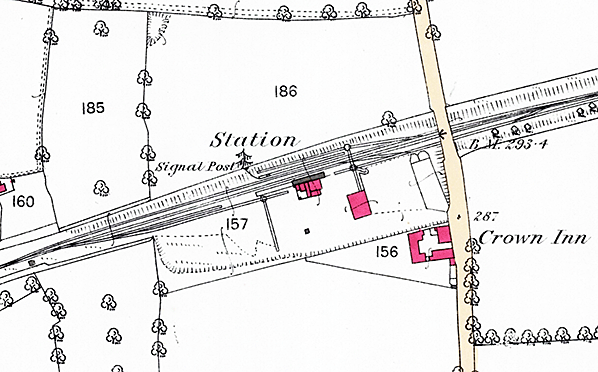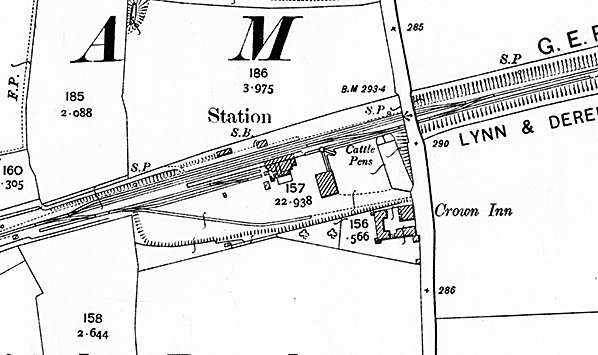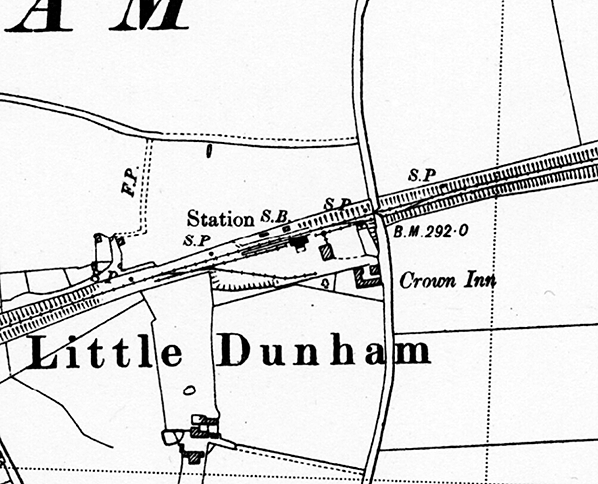Notes: Notes: Dunham station was 18 miles and 36 chains from Lynn. Following closure of the temporary terminus of the line at Sporle in 1850 it was the first stop after Swaffham for down trains. At this point the line was on a long curve that changed its direction from roughly north-eastwards (for down trains) to a more easterly direction. The station’s principal buildings comprising a substantial station house and office and an imposing large goods shed lay on the south side of the running lines. Dunham was constructed as a passing place with two platforms on the single line. The station house had its main roof-line at a right-angle to the track but on its east face there was a gable. On its west side there were several single-storey outbuildings. A projecting roof, part of but at a lesser angle than the main roof, covered a ground floor extension. There were several large chimney stacks, none of them along the roof-line itself. The station house was constructed of beige coloured corner supports inset with finely knapped local flint, together resulting in a very pleasing finish. In July 1853 the Dunham stationmaster was a J.C.Lunn.
 The station site extended under a wide bridge taking the lane from Little Dunham, to the station’s south, to Great Dunham a mile or so to its north. Three lines ran under the bridge - the up and down running lines and a goods loop south of them. At first a siding, shunted from the east, ran off the down station line near the bridge ending behind the down passenger platform. At the west end of the station two further sidings were shunted from the west off the up running line. The station site extended under a wide bridge taking the lane from Little Dunham, to the station’s south, to Great Dunham a mile or so to its north. Three lines ran under the bridge - the up and down running lines and a goods loop south of them. At first a siding, shunted from the east, ran off the down station line near the bridge ending behind the down passenger platform. At the west end of the station two further sidings were shunted from the west off the up running line.
On the south side of the line one of the sidings was used as a carriage dock but by 12 May 1857 the dock was in use as a coal wharf by a Mr. Blythe. On 2 Sept 1857 the requirement for a proper coal depot at Dunham was identified. This would appear to be the end of Mr Blythe's use of the carriage dock. Over the years, Dunham's platforms were lengthened several times, the first lengthening was authorised 25 May 1859. On 14 June 1865 costings presented to Board for additional sidings at Dunham at a cost of £156. This possibly refers to the coal siding along the southern boundary of the station site but this didn't appear until after 1885.
The impressive goods shed unusually had its railway access at ninety degrees to the main line. It was built of red brick corner supports and, like the station, was inlayed with knapped flint. Two doors opened towards the main line and one large door on the west side, with a semi-circular top, opened onto the public yard. Access for rail wagons was achieved by use of wagon turntables. In 1884 one was on a headshunt from the goods loop on the up side. Somewhat unusually, another turntable was provided exactly opposite the first, on the siding off the down line. Rails between the two crossed the running lines on the level. Yet another wagon turntable came off one of the west end sidings with a track projecting into the station yard. A 1-ton capacity crane was located in the yard. When a new OS map was published in 1905 it showed that the down siding, its turntable and the rails across the running lines had gone, as had the turntable at the west end: it was replaced with a new longer siding which served the coal depot; coal bins were sited alongside this siding. Cattle pens occupied the area in the lea of the road bridge’s embankment. The Crown Inn was a prominent building on the roadside at the station yard entrance.

On 20 April 1886 a signalling contracts was awarded to Messrs. Saxby & Farmer. The LNER recorded that the box had a 30-lever frame. With this work completed, Dunham became a block station. The 30-lever frame was still in use into BR days.
In early Edwardian times the Great Eastern Railway enhanced provision for passengers. The platforms were extended and a large heated waiting room, built of red brick under a pitched tiled roof, was constructed on the down platform. This was to accommodate a lengthening of the down platform to the west. The removal of the sidings on the north side of the line allowed a widening of the platform. The new signal box was built on the platform a few yards to the east of the waiting room.
As the 1885 map reproduced below shows a signal post there was clearly some form of signal control in place prior to 1886. There was either an earlier signal box not shown on the map, or a hut with ground frame, perhaps located away from the immediate environs of the station.
 As he has done for other stations on this line, Stanley C Jenkins researched the names of Station Masters and other staff at Dunham for his book about the Lynn & Dereham. He tells us that one of the first in charge was Mr C Underhill presumably replacing Mr Lunn. After 1890 he was succeeded, in turn, by Alfred Page and Herbert Youell. In 1908 James Andrews was Station Master who stayed through Great War and served at Dunham for 20 years. He served alongside one William Ellis who worked as a porter from September 1872 until he retired in April 1921. Other porters there included John Etheridge, who married a female Booking Clerk, Gertrude Palmer, Harry Minns and John Sidney Neale, both of whom volunteered for the Army at the start of the conflict in 1914. As he has done for other stations on this line, Stanley C Jenkins researched the names of Station Masters and other staff at Dunham for his book about the Lynn & Dereham. He tells us that one of the first in charge was Mr C Underhill presumably replacing Mr Lunn. After 1890 he was succeeded, in turn, by Alfred Page and Herbert Youell. In 1908 James Andrews was Station Master who stayed through Great War and served at Dunham for 20 years. He served alongside one William Ellis who worked as a porter from September 1872 until he retired in April 1921. Other porters there included John Etheridge, who married a female Booking Clerk, Gertrude Palmer, Harry Minns and John Sidney Neale, both of whom volunteered for the Army at the start of the conflict in 1914.
Whilst other stations became request stops for passenger trains quite soon after the line opened, Dunham did not. The 1866 timetable shows three trains calling in each direction on weekdays and one on Sundays. In addition, on Saturdays, a train bound for Norwich and its market, not shown in the tables, called at about 8.40am. Market-goers returned on the 5.20pm from the city and changed at Dereham, their train guaranteed to wait for the arrival from Norwich.

By 1882 the service was better. An up train left at 8.12am, presumably in connection with the large Tuesday Market at Lynn: on other weekday a mixed ran more or less in its path when starting out from Dereham but gradually increased the difference so that by Lynn it was 85 minutes later in its arrival time. Five further trains followed on weekdays but the Sunday train had gone from the tables. Going down, the market train to Norwich was now in the timetable, leaving at 9.00am on Saturdays. It was followed by five trains to Dereham. The return Tuesday only train from Lynn called at 9.04pm, its path filled by a mixed on Wednesdays only. On Mondays another mixed called at 9.58pm.
 By LNER days in 1925 the mixed trains no longer ran. Dunham saw six up trains, seven on Saturdays, and no Sunday workings. Five down trains called plus an extra one on Saturdays only. In 1932 Dunham’s farmers and traders were served by an up direction pick-up goods that stopped from 8.45am and 9.05am and another in the afternoon, its time varying between weekdays and Saturdays. In the down direction the pick-up might be found at Dunham from 2.00pm until 2.30pm except on Tuesdays and Saturdays. On Saturdays, it arrived at 2.39 and stayed 16 minutes. By LNER days in 1925 the mixed trains no longer ran. Dunham saw six up trains, seven on Saturdays, and no Sunday workings. Five down trains called plus an extra one on Saturdays only. In 1932 Dunham’s farmers and traders were served by an up direction pick-up goods that stopped from 8.45am and 9.05am and another in the afternoon, its time varying between weekdays and Saturdays. In the down direction the pick-up might be found at Dunham from 2.00pm until 2.30pm except on Tuesdays and Saturdays. On Saturdays, it arrived at 2.39 and stayed 16 minutes.
Diesel Multiple Units took over all passenger workings from the beginning of the 1955 winter timetable. The line saw a big increase in services: eleven up trains bound for Lynn stopped at Dunham, one more ran only to Swaffham where a change for Lynn was offered. Thirteen down trains stopped: one came from Thetford via Watton. There was no Sunday service on the line.
Despite BR’s modernisation attempts the end was signalled in Dr. Richard Beeching’s report The Reshaping of Britain’s Railways, published in March 1963 and closure of Norfolk’s branch lines began with some urgency. Additionally services on the Lynn & Dereham were run down by closure of general goods facilities at intermediate stations. The station’s passing loop was removed leaving only the former down platform in use. In August 1966 Dunham became an unstaffed halt for the first time - some other stations had been so for some years in the 1860s and 70s. Closure notices were served in 1968 and the line, including Dunham station, closed to passengers with effect from 9 September 1968, with the last trains running on Saturday 7 September
Route map dawn by Alan Young. Tickets from Michael Stewart.
Additional source GER board minutes. Additional research by Darren Kitson.
Click here for a brief history of the Lynn & Dereham Railway
See other stations on the Swaffham - Dereham line: Middleton Towers, East Winch, Pentney & Bilney, Narborough & Pentney, Swaffham, Sporle, Fransham, Wendling, Scarning & Dereham (E & A station) |










.jpg)
 The station site extended under a wide bridge taking the lane from Little Dunham, to the station’s south, to Great Dunham a mile or so to its north. Three lines ran under the bridge - the up and down running lines and a goods loop south of them. At first a siding, shunted from the east, ran off the down station line near the bridge ending behind the down passenger platform. At the west end of the station two further sidings were shunted from the west off the up running line.
The station site extended under a wide bridge taking the lane from Little Dunham, to the station’s south, to Great Dunham a mile or so to its north. Three lines ran under the bridge - the up and down running lines and a goods loop south of them. At first a siding, shunted from the east, ran off the down station line near the bridge ending behind the down passenger platform. At the west end of the station two further sidings were shunted from the west off the up running line. 
 As he has done for other stations on this line, Stanley C Jenkins researched the names of Station Masters and other staff at Dunham for his book about the Lynn & Dereham. He tells us that one of the first in charge was Mr C Underhill presumably replacing Mr Lunn. After 1890 he was succeeded, in turn, by Alfred Page and Herbert Youell. In 1908 James Andrews was Station Master who stayed through Great War and served at Dunham for 20 years. He served alongside one William Ellis who worked as a porter from September 1872 until he retired in April 1921. Other porters there included John Etheridge, who married a female Booking Clerk, Gertrude Palmer, Harry Minns and John Sidney Neale, both of whom volunteered for the Army at the start of the conflict in 1914.
As he has done for other stations on this line, Stanley C Jenkins researched the names of Station Masters and other staff at Dunham for his book about the Lynn & Dereham. He tells us that one of the first in charge was Mr C Underhill presumably replacing Mr Lunn. After 1890 he was succeeded, in turn, by Alfred Page and Herbert Youell. In 1908 James Andrews was Station Master who stayed through Great War and served at Dunham for 20 years. He served alongside one William Ellis who worked as a porter from September 1872 until he retired in April 1921. Other porters there included John Etheridge, who married a female Booking Clerk, Gertrude Palmer, Harry Minns and John Sidney Neale, both of whom volunteered for the Army at the start of the conflict in 1914. 
 By LNER days in 1925 the mixed trains no longer ran. Dunham saw six up trains, seven on Saturdays, and no Sunday workings. Five down trains called plus an extra one on Saturdays only. In 1932 Dunham’s farmers and traders were served by an up direction pick-up goods that stopped from 8.45am and 9.05am and another in the afternoon, its time varying between weekdays and Saturdays. In the down direction the pick-up might be found at Dunham from 2.00pm until 2.30pm except on Tuesdays and Saturdays. On Saturdays, it arrived at 2.39 and stayed 16 minutes.
By LNER days in 1925 the mixed trains no longer ran. Dunham saw six up trains, seven on Saturdays, and no Sunday workings. Five down trains called plus an extra one on Saturdays only. In 1932 Dunham’s farmers and traders were served by an up direction pick-up goods that stopped from 8.45am and 9.05am and another in the afternoon, its time varying between weekdays and Saturdays. In the down direction the pick-up might be found at Dunham from 2.00pm until 2.30pm except on Tuesdays and Saturdays. On Saturdays, it arrived at 2.39 and stayed 16 minutes. 
 Home Page
Home Page